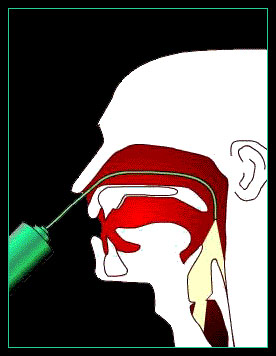 Two quite specialised tools allow us to see the vocal folds even though they are positioned quite low in the throat.
Two quite specialised tools allow us to see the vocal folds even though they are positioned quite low in the throat.
The first tool is Rigid Endoscopy
A Rigid Endoscope is a slender rod with a prism set into the tip at a 70 degree angle. This provides a light source, and conveys images to an attached video camera. The rigid scope is inserted from the mouth, through the oral cavity, and positioned just short of the back wall of the pharynx. The angled prism looks down directly at the vocal folds.
You can see the position of the rigid scope in the diagram.
Advantages:
- provides brilliantly clear images.
- The rod is easy to control and position.
Disadvantages:
- The architecture of some people’s oral cavities prevents getting the scope over the tongue body and under the velum without seriously triggering their gag reflex.
- Most rigid scoped patients have to pull their tongue tip forward with their fingers, in order to get the best view. This, and having a scope in your oral cavity, makes speech impossible. So rigid scoping is great for looking at static folds, and allows some crude phonation, but is not good for looking at phonation in real speech.

The second tool is Flexible Endoscopy
A Flexible Endoscope is a slender flexible hose with a prism set into the tip which provides a light source, and conveys images to an attached video camera. However the light and images pass through a bundle of fibre-optic cables. The flexibility of this cable means that it can be fed through the nasal cavity, dropped down through the pharynx, and positioned directly above the vocal folds.
You can see the position of the flexible scope in the diagram.
Advantages:
- The flexible scope is less uncomfortable than you’d expect, and if properly positioned should not cause gagging problems.
- As the flexible scope doesn’t interfere with the tongue, lips, etc. it allows you to see the vocal folds moving in fairly normal speech.
Disadvantages:
- The images recorded through a flexible scope have to pass through a bundle of fibers, so the resolution achieved is not nearly as good as you get with a larger rigid scope.
- The tip of a flexible scope is much harder to position accurately, compared with a rigid scope, and it can interfere with natural raising of the velum, causing speech to be more nasalised than normal.
- There’s just no nice way to say this… it can be hard sometimes to keep your lens clean during the trip through the nasal cavity.
Slowing the Vibration Down
Vocal fold vibrations are measured as “cycles per second’ or Hertz. The low end of a man’s phonation range may be as low as about 80 cycles per second. The high end of a woman’s phonation range may be as high as about 400 cycles per second. These differences are due to the length and tensioning of the vocal folds.
All these speeds of vibration are just too fast to be seen with the naked eye. However a technique called ‘stroboscopy’ creates the allusion that the folds are moving in slow motion. Here’s how it works.
You use a endoscope, but instead of a steady light source, you add a strobe light which repeatedly emits a short bright flash. If the flash occurs at exactly the same point in the vibration cycle (say the point where the folds are closed), then the folds will appear to be frozen shut. However if you alter the timing of the flash so that it is just slightly faster or slower than the rate of vibration, then the flash catches the cycle at a slightly different point each time, and you create the allusion that the folds are moving in slow motion.
Play the video to see this for yourself. The video is of normal voiced [i], and it is recorded at normal speed (the audio track will confirm this). The stroboscopy will make it appear slow, and this gives you a good chance to see the action of the folds.